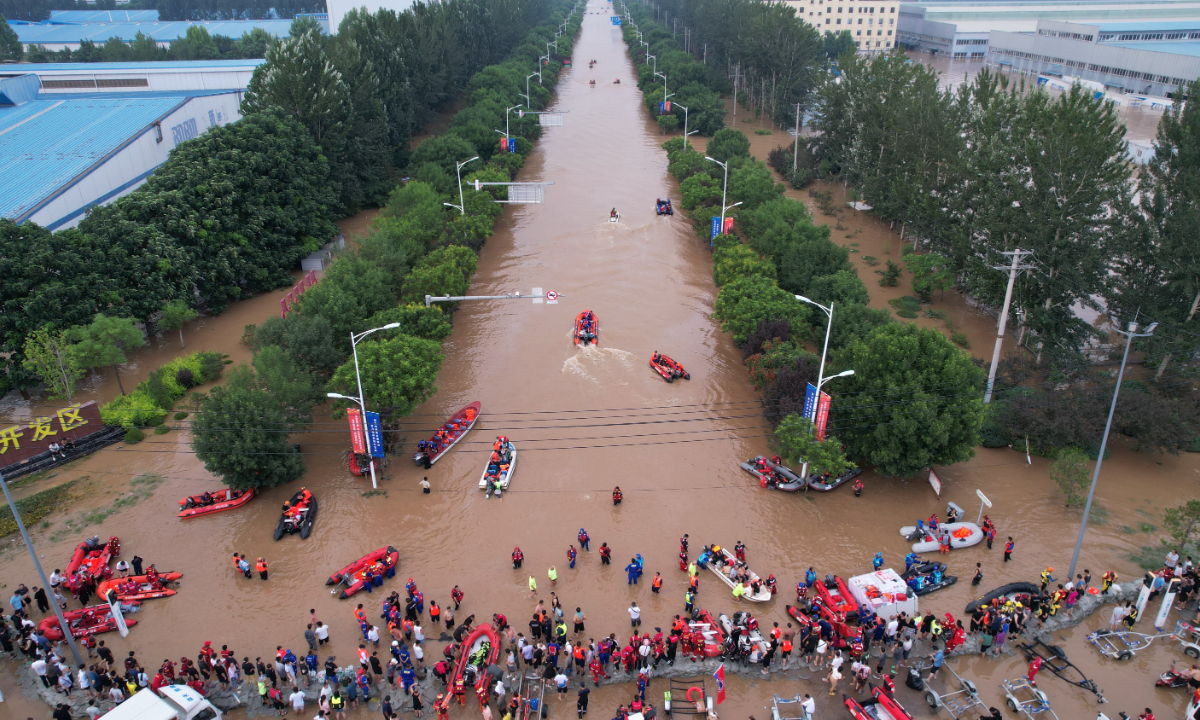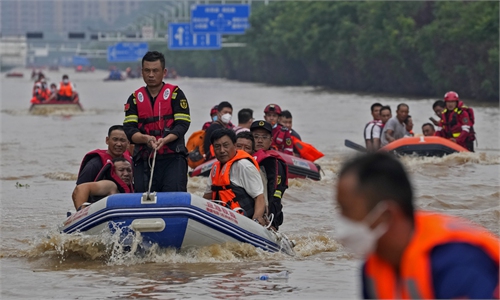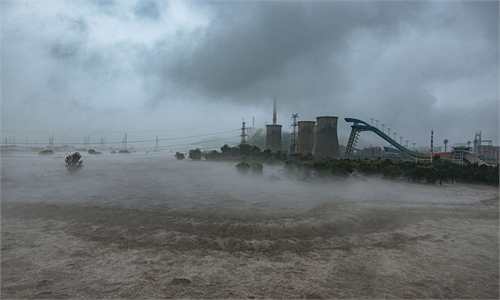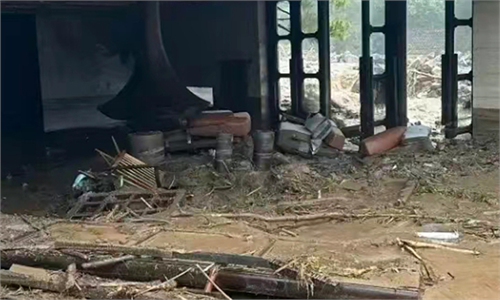N. China's Hebei uses seven storage areas and 155 reservoirs to control floods and reduce downstream pressure

Rescue teams evacuate residents by rubber boats in Zhuozhou, North China's Hebei Province on August 2, 2023. The region has been hit by floods due to heavy rainfall. Photo: IC
North China's Hebei Province has successively put seven flood storage and detention basins in use to control the floods and decrease the impact of the flooding and waterlogging across downstream rivers and important areas. The local department of water resources expected it will take up to one month for the water in these basins to recede.
Zhuozhou city in Hebei where multiple rivers are located and some places used as flood storage basins have been heavily stricken by flooding caused by heavy rainstorms across the Beijing-Tianjin-Hebei region due to the remnants of Typhoon Doksuri.
According to Li Na, deputy director of the Department of Water Resources of Hebei Province, average rainfall in Zhuozhou amounted to 398 millimeters as of Wednesday evening during this round of rainstorm. The multiple rivers flowing past Zhuozhou have had a significant impact on the city. The maximum flood peak of the upstream of the Beijuma River reached 4,500 cubic meters per second while the water inflow of the Liuli River and Xiaoqing River also exceeded 3,000 cubic meters per second, China Central Television (CCTV) reported.
Despite rainfall easing, it will take some time for the water level to recede and 300 million to 400 million cubic meters of water is expected to pass flow across Zhuozhou, Li said.
According Li, the flood storage and detention basins have proven to be very effective in reducing the impact of flooding and mitigate potential damage to the downstream Xiong'an New Area and Tianjin Municipality.
For some villages used as flood storage and detention basins, it will take as little as one week for water levels to recede in elevated areas whereas it will take longer, even up to one month, for the water to recede in low-lying areas, Li noted.
At present, China's State Flood Control and Drought Relief Headquarters continues to remain at a Level-II emergency response to flooding in Beijing, Tianjin, Hebei, Shanxi and Henan provinces as flood waters in the middle reaches of the Haihe River Basin progress downstream, and various flood control measures, including flood storage areas, diversion channels, and floodwater detention reservoirs, are successively put into use.
According to Yang Guang, an official from the Flood and Drought Disaster Prevention Department of China's Ministry of Water Resources, rainfall along the Haihe River Basin has basically stopped. A total of eight flood storage and detention basins and 155 large- and middle-scale reservoirs along the Haihe River Basin have been put into use to give full play to the role of flood control and disaster relief, CCTV reported.
In the heavily affected Beijing-Tianjin-Hebei region, 79 large and medium-sized reservoirs have been put into use to store 2.4 billion cubic meters of floodwater, effectively reducing the flood control pressure downstream, Yang said.
In particular, maximum inflow at Wangkuai Reservoir in the Daqing River system was 3,667 cubic meters per second, with a corresponding outflow of 300 cubic meters per second, resulting in a peak flow reduction rate of 91.8 percent. This has effectively reduced the flood control pressure in Xiong’an New Area, Yang noted.
Local officials have also provided emergency relief services to local residents who have been affected by the flooding.
At the largest resettlement site in Zhuozhou put into use on the night of Monday, over 2,000 disaster-stricken residents are provided with three meals a day and medical treatment and services in necessity.
A further 39 stranded residents in a residential compound where an underground garage collapsed, suffering water backflow due to flooding in Zhuozhou, have been rescued by helicopter operated by a civil rescue team as of 5 pm on Wednesday.
Moreover, around 2,700 passengers on three trains stranded on the Fengsha railway connecting Fengtai district in Beijing and Zhangjiakou city in Hebei, have all been transferred to safe locations as of Wednesday midnight.
Global Times




